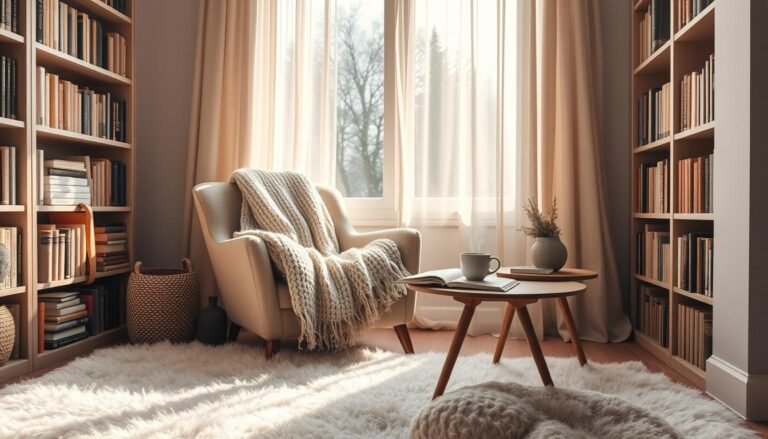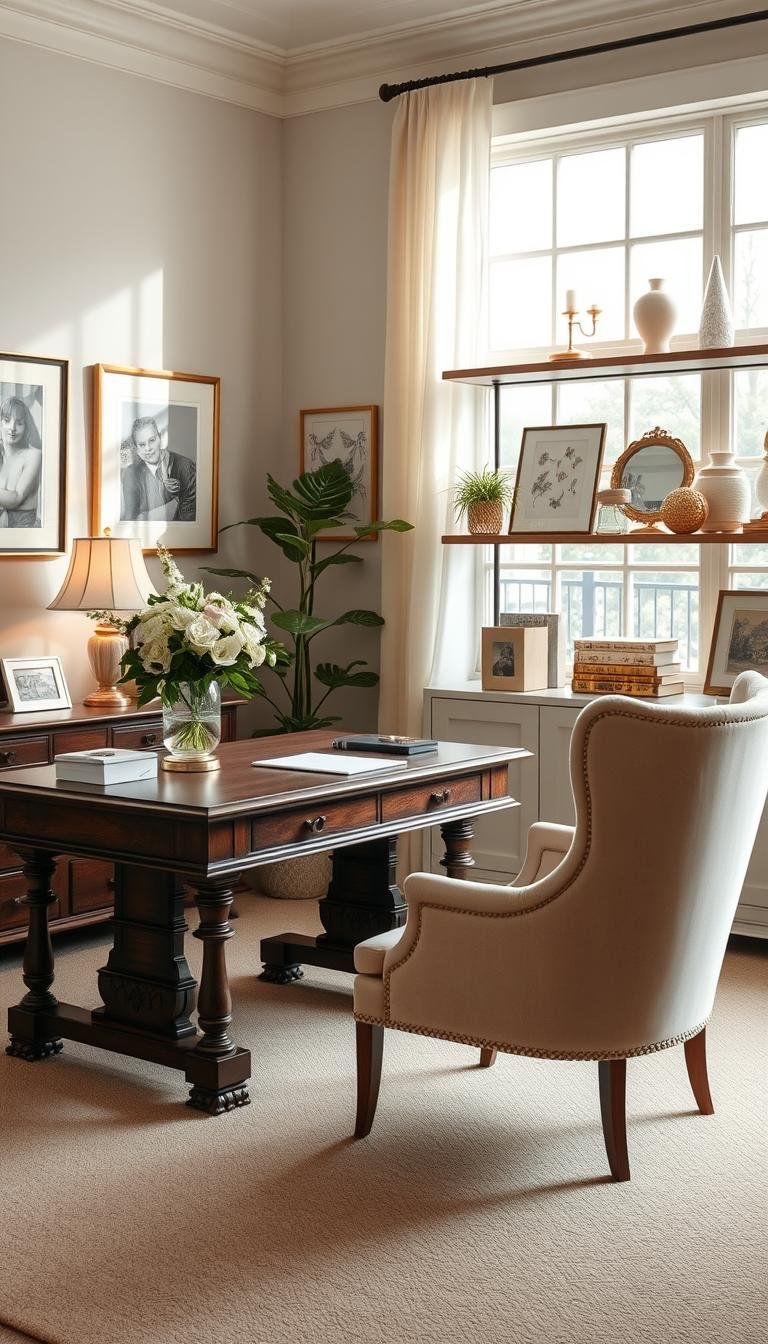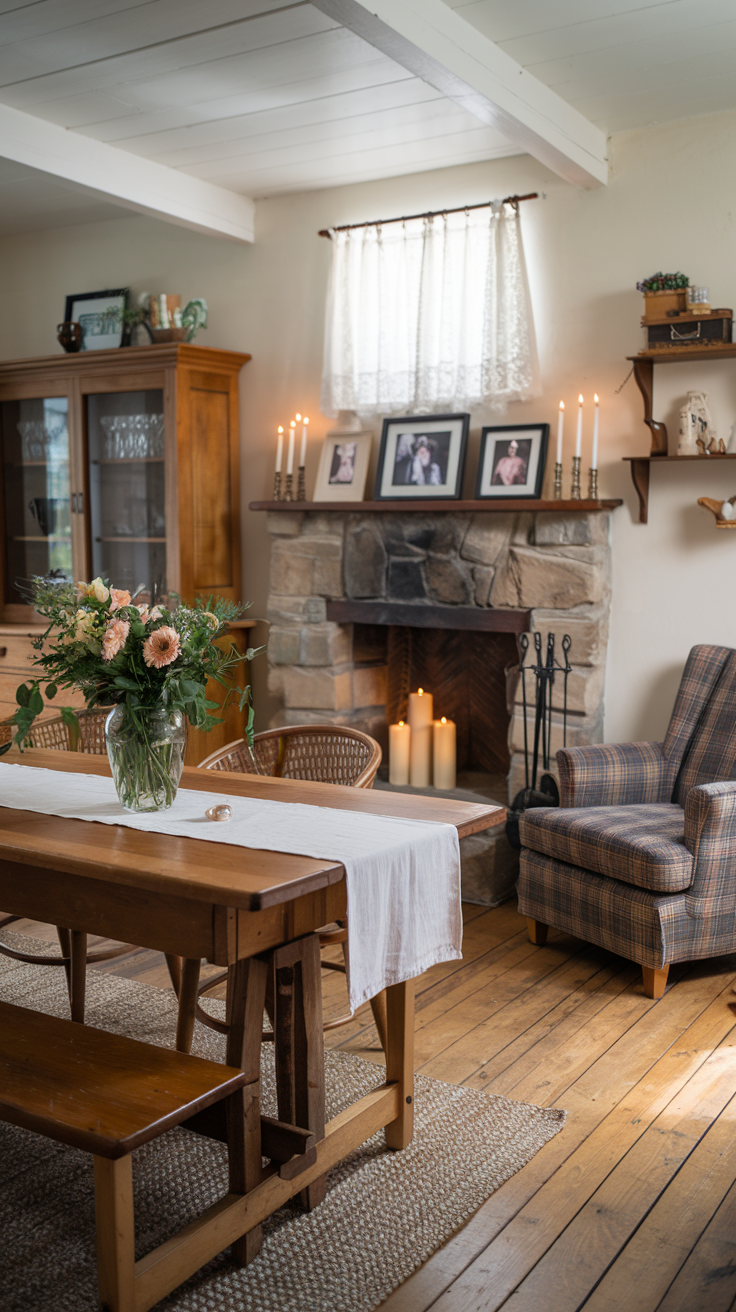Discover The secret to making small spaces feel luxurious
Square footage doesn’t define elegance. Many assume lavish interiors require sprawling layouts, but designers at firms like Urban Rhythm prove otherwise. With intentional choices, even 100-square-foot areas can radiate sophistication.
Your home’s potential lies in strategic curation – not expansion. Light-reflecting mirrors add depth, while vertical storage solutions turn blank walls into functional art. Consider how bathroom makeovers use floating vanities to merge practicality with sleek aesthetics.
Color psychology plays a quiet yet powerful role. Pale hues visually recede, creating airiness. A single navy accent wall adds drama without shrinking perceptions. Texture layers – velvet cushions against matte ceramics – engage multiple senses simultaneously.
Key Takeaways
- Intentional design trumps square footage for creating upscale environments
- Vertical space utilization doubles functionality without clutter
- Strategic lighting placement enhances perceived dimensions
- Monochromatic schemes with texture variations maintain visual interest
- Multi-functional furniture serves as both artwork and utility
- Reflective surfaces amplify natural light distribution
This approach transforms limitations into creative catalysts. Your living area becomes a gallery, bedroom a sanctuary, kitchen a chef’s studio – each space thoughtfully composed. The true luxury lies not in size, but in how every element harmonizes.
Understanding the Secret to Making Small Spaces Feel Luxurious
Luxury in compact areas emerges from deliberate curation, not square footage. Designers at firms like Studio McGee reveal how restraint amplifies impact – three intentional elements often outweigh ten random pieces. Your living room becomes a case study in this philosophy, where each object earns its place through form and function.
Clutter dissolves perceived value faster than poor lighting. Start by auditing your room with fresh eyes: which items serve practical needs versus collecting dust? A floating shelf displaying one sculptural vase often speaks louder than crowded knickknacks. This editing process creates breathing room for quality pieces to shine.
Consider texture pairings as your silent allies. A wool throw draped over streamlined leather seating adds tactile contrast without visual noise. In dining nooks, custom banquettes with hidden storage merge comfort with clever space use. These choices transform limitations into curated moments.
Lighting placement proves crucial. A single statement chandelier draws eyes upward, making ceilings appear higher. Wall sconces flanking artwork eliminate bulky floor lamps, preserving precious square footage. Remember: luxury lives in the harmony between empty areas and chosen accents.
Optimizing Layout with Minimal Furniture
Sophisticated compact living areas demand careful furniture curation. Begin by measuring your room’s walkways and focal points. A well-planned arrangement creates visual flow while maintaining essential functions.
Choosing Statement Pieces Over Clutter
Select two or three hero items that command attention. A sculptural chair with clean lines or a slender console table with marble inlay serves dual purposes. These pieces become functional art while reducing visual noise.
Consider scale carefully. An oversized lamp base paired with a petite side table creates dynamic contrast without overcrowding. Rotate decorative objects seasonally to maintain freshness without accumulation.
Multipurpose Furniture for Versatile Living
Modern designs solve spatial challenges elegantly. Look for:
- Sleeper sofas with built-in USB ports
- Nesting coffee tables that separate for entertaining
- Ottomans with lift-top storage compartments
These solutions help your room adapt throughout the day. A breakfast nook becomes a workspace by afternoon, then transforms into a cocktail corner by evening – all through strategic furniture choices.
Enhancing Your Space with Light Paint and Flowing Flooring
Color and texture choices act as invisible architects in compact environments. When walls define your canvas, strategic surface treatments become your most reliable tools for crafting openness. Consider how morning light interacts with eggshell walls or how hardwood grains guide the eye across a room’s length.
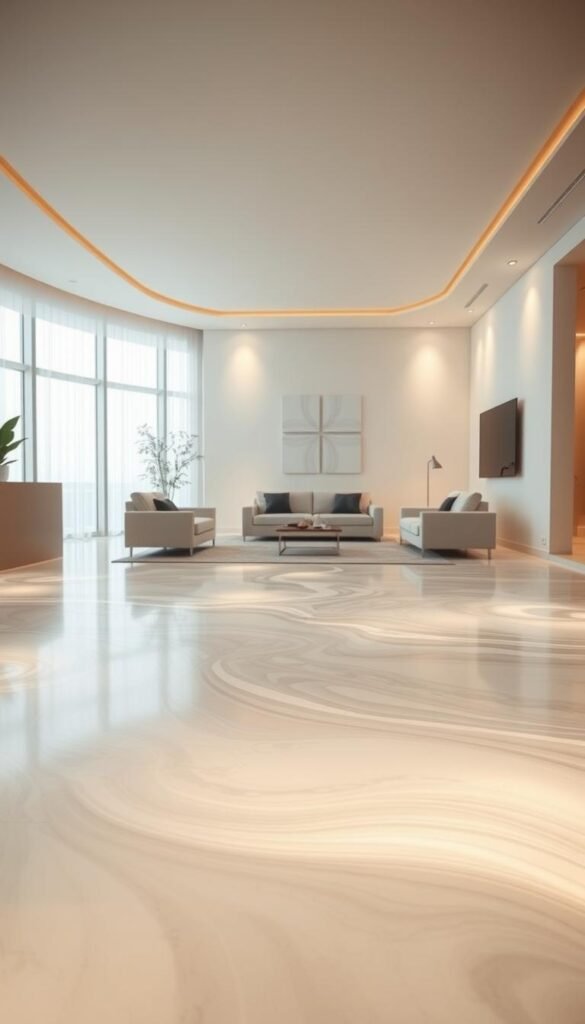
Using Light Colors to Reflect Natural Light
Light colors work like optical enhancers. Pale shades such as pearl gray or soft linen bounce sunlight deeper into corners, reducing shadow pockets that shrink perceived space. For trim, match it to your walls rather than using stark white – this seamless transition erases visual edges.
Cool undertones in paint create calmness, while warm ivories add subtle coziness. Test samples at different times of day. A north-facing room might need buttery tones to counter gray light, whereas southern exposures can handle crisper hues without feeling sterile.
Creating Flow with Consistent Flooring
Your floor acts as a unifying foundation. Continuous materials like wide-plank oak or large-format tiles minimize visual breaks between areas. In open-plan layouts, this consistency helps define zones without physical dividers.
For smaller rooms, extend the same flooring into adjacent hallways. This elongation trick makes square footage feel interconnected. If replacing surfaces isn’t feasible, use low-pile rugs in matching tones to maintain flow while adding texture underfoot.
Utilizing Natural Light and Reflective Surfaces
Light transforms compact environments like nothing else. When harnessed thoughtfully, it dissolves boundaries and reveals hidden dimensions. Start by assessing your room’s relationship with sunlight throughout the day – notice where shadows linger and where brightness naturally pools.
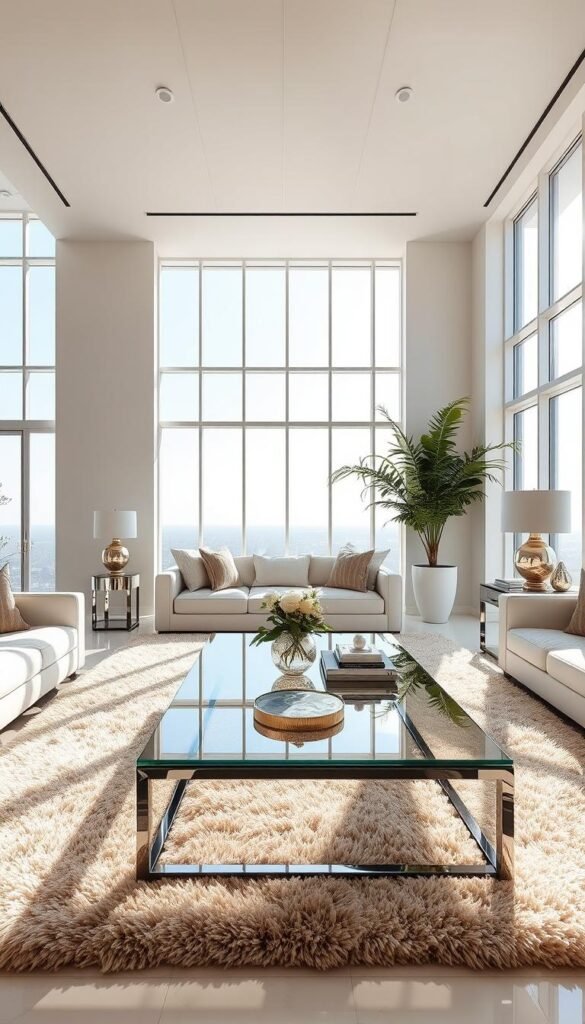
Maximizing Window Light Exposure
Uncovered windows act as natural magnifiers. Sheer linen curtains soften glare while maintaining brightness. For rooms with limited openings, position seating areas near existing windows to claim every sunbeam.
Consider window treatments that disappear when not needed. Cellular shades tuck neatly into frames, while motorized blinds adjust with a tap. These solutions preserve views without sacrificing privacy.
Strategic Mirror Placement for Depth
Reflective surfaces work as visual amplifiers. A well-positioned mirror opposite a window doubles sunlight penetration. Try these placements:
- Full-length panels flanking a fireplace
- Circular accents above console tables
- Oversized floor mirrors angled toward focal points
Matte metallic finishes on decorative objects add subtle shimmer without overwhelming. A brass tray or nickel lamp base catches light differently than glossy surfaces, creating layered luminosity.
Remember: balance prevents spaces from feeling like hall of mirrors. Pair reflective elements with matte textiles or rough-hewn wood to ground the room’s energy.
Simplifying Window Treatments for a Luxurious Look
Windows frame your world – how you dress them shapes a room’s entire character. Designers increasingly favor streamlined solutions that complement rather than compete with views. The right treatments can turn glass portals into sculptural elements while maintaining airiness.
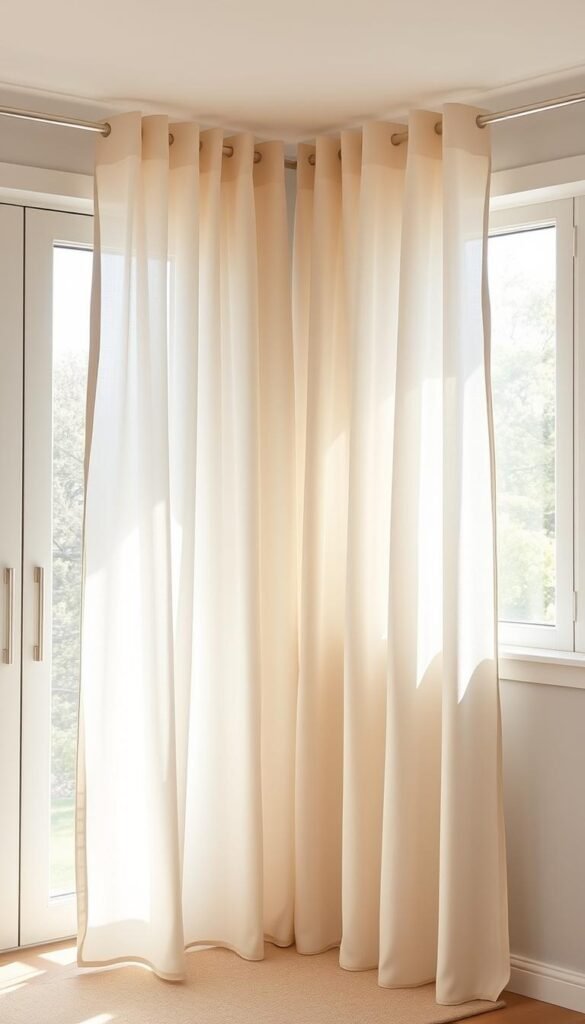
Minimalist Blind and Curtain Options
Heavy drapes belong to another era. Modern alternatives like cellular shades or linen-textured rollers preserve sightlines while softening light. Top interior experts recommend these space-enhancing strategies:
- Ceiling-mounted tracks creating vertical elongation
- Sheer vertical panels that diffuse without blocking
- Motorized solar screens adjusting to daylight levels
Notice how these choices eliminate fabric pooling on floors. A single crisp Roman shade in a room’s accent color adds polish without bulk. For narrow windows, try inside-mount blinds that sit flush with frames.
Function meets form in unexpected ways. Rolling bamboo screens bring organic texture, while metallized roller shades offer subtle reflectivity. The key lies in choosing mechanisms that disappear when not needed – your space remains the star.
These approaches prove particularly effective in urban apartments and cottages. They honor architectural lines while preventing visual fragmentation. Remember: understatement often carries more weight than ornamentation in cultivated interiors.
Elevating Home Decor Through Thoughtful Details
Subtle refinements separate ordinary rooms from extraordinary environments. While grand gestures attract attention, true sophistication emerges through curated accents that whisper rather than shout. This approach transforms everyday living into an artful experience.
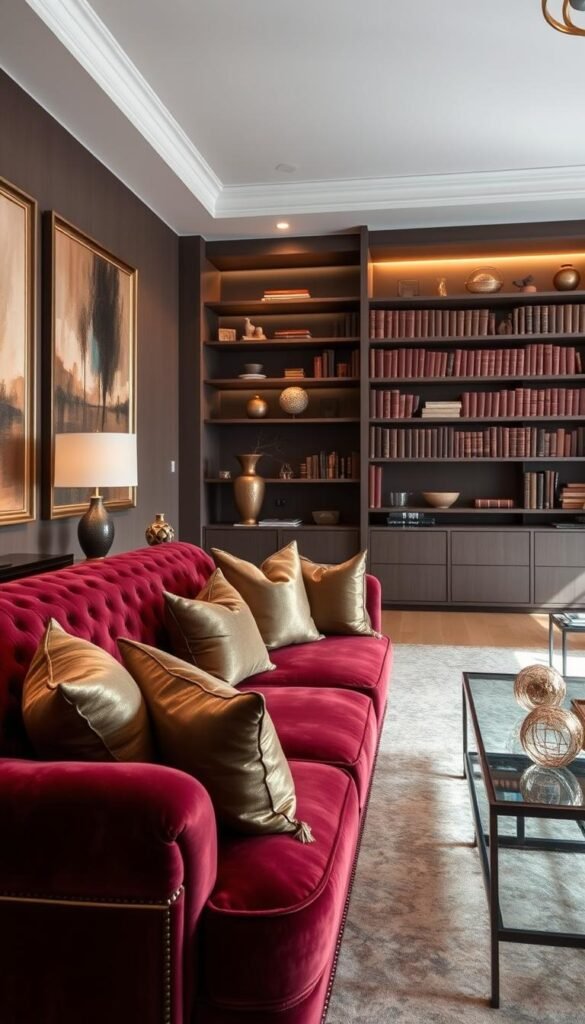
Curating Textural Narratives
Luxury lives in the drape of fabric and brushstrokes of artwork. A single designer-grade throw pillow with hand-stitched details can anchor an entire seating area. Consider tactile pairings: nubby linen curtains against smooth ceramic vases, or a silk-bound coffee table book resting on weathered wood.
Art selections should spark dialogue while complementing your room’s energy. Oversized abstract paintings work well in minimalist spaces, while clustered botanical prints add whimsy to traditional settings. Remember: frames matter as much as the art itself. Thin metallic borders modernize vintage pieces, while chunky wood mouldings ground contemporary works.
Practical elegance shines through multi-functional decor:
- Hand-knotted wool rugs defining conversation zones
- Handblown glass lamps doubling as sculptural elements
- Antique trunks serving as both storage and side tables
These choices demonstrate how every addition should earn its place through beauty and utility. Your home becomes a gallery of intentionality, where even functional items contribute to the aesthetic narrative.
Experiment with scale in accessories. A massive floor vase holding a single branch creates drama, while petite crystal decanters on a bar cart add sparkle. The magic lies in balancing statement pieces with breathing room – let each treasure shine without competition.
Implementing The secret to making small spaces feel luxurious
Transforming cozy environments begins with merging strategy and artistry. Imagine your space as a tailored suit – every measurement precise, each detail purposeful. This mindset shifts implementation from daunting to exhilarating, turning constraints into creative fuel.
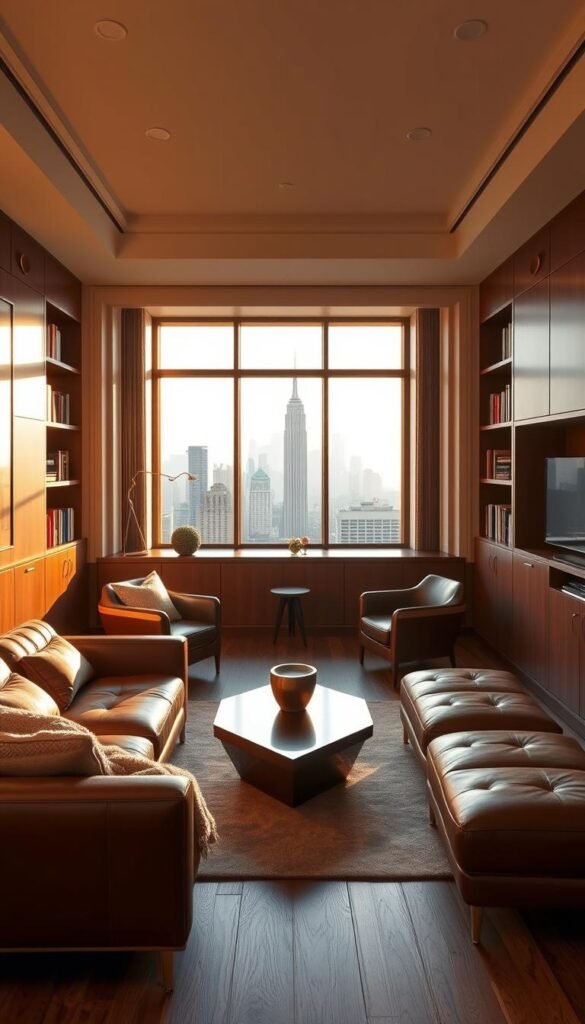
Start by mapping your room’s daily rhythms. Where does morning coffee happen? Which zones need evening tranquility? A streamlined table serving as breakfast spot, work desk, and cocktail station exemplifies smart multifunctionality. Pair it with chairs that tuck neatly beneath when not in use.
Color schemes gain power through repetition. Carry your wall’s soft sage hue into textiles and art accents. This continuity calms the eye while making the room feel expansive. Lighting follows similar logic – layer sconces, pendants, and LED strips to adapt moods without bulky fixtures.
Three implementation essentials:
- Anchor with one showstopping element (marble console, hand-knotted rug)
- Edit ruthlessly – keep only what serves beauty or purpose
- Test layouts using painter’s tape before committing
Your choices accumulate like brushstrokes on canvas. That lacquered side table isn’t just storage – it’s a light-reflecting surface that helps make room dimensions sing. Remember: luxury lives in the harmony between empty areas and intentional accents.
Smart Storage Solutions for a Clutter-Free Home
Clutter-free living begins where smart storage meets design. Imagine your favorite room functioning like a Swiss Army knife – every compartment purposeful, every surface intentional. This approach transforms cramped quarters into streamlined environments that breathe.
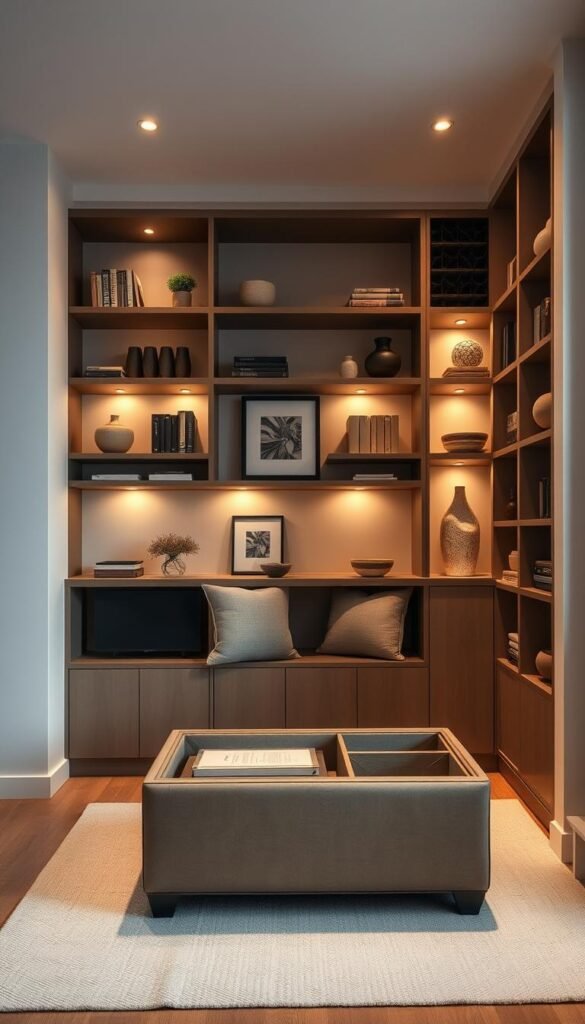
High and Hidden Storage Techniques
Vertical real estate often goes untapped. Floating shelves 18 inches below ceiling height create display space for books or plants, while shallow cabinets above door frames store seasonal items. In kitchens, magnetic knife strips replace bulky blocks, freeing counter space.
Furniture becomes a storage ally when chosen wisely. Consider ottomans with lift-up seats for blankets or beds with built-in drawers. A slim console table behind your sofa might hide charging stations and remotes behind discreet doors.
Three stealthy solutions for modern interior spaces:
- Mirrored medicine cabinets doubling as jewelry organizers
- Staircase drawers in multi-level homes
- Window seat cubbies with weatherstripped lids
These strategies keep essentials within reach yet out of sight. Your room maintains its airy feel because storage works quietly behind the scenes. The result? Spaces that feel curated, not crowded.
Designing Small Space Dining and Multipurpose Areas
Efficient layouts turn tight quarters into inviting hubs. Your dining area becomes more than a meal spot – it’s where morning productivity meets evening relaxation. Start by viewing your kitchen and living zones as interconnected partners rather than separate rooms.
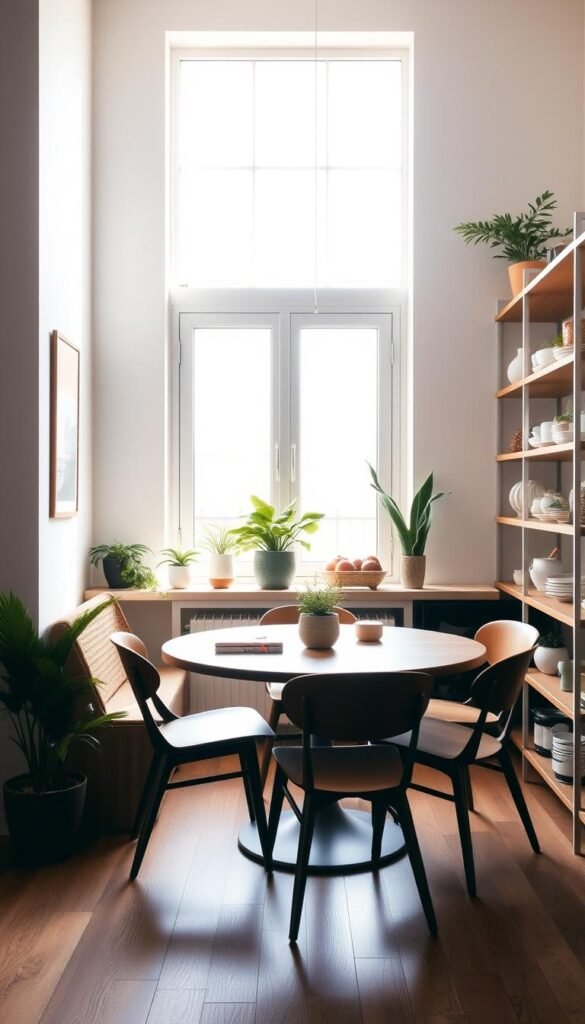
Choosing Appropriately Sized Furniture
Scale determines success in compact dining setups. A 36-inch round pedestal table seats four comfortably without dominating the room. Look for extendable designs that tuck against walls when not hosting guests. Pair with armless chairs that slide completely underneath.
Convertible pieces shine in dual-purpose spaces. A coffee table with lift-top mechanisms transforms into a dining surface for two. Nesting side tables provide extra surface area during gatherings, then stack neatly afterward. These solutions honor your need for flexibility.
Customizing Nooks for Functionality
Awkward corners hold hidden potential. That 45-inch gap between cabinets could become a banquette breakfast nook with built-in storage. Add cushions in durable indoor-outdoor fabric for easy cleaning. Under-seat compartments hide table linens or board games.
Consider these space-enhancing strategies:
- Wall-mounted drop-leaf tables for impromptu meals
- Bar carts doubling as portable serving stations
- Magnetic spice racks on kitchen backsplashes
Your living area gains depth when furniture serves multiple roles. A console behind the sofa becomes a buffet during dinner parties, while floating shelves display serveware as functional decor. The small space feel dissolves through intelligent adaptation.
Creating Ambiance with Strategic Lighting and Decor
Ambient environments emerge from thoughtful interplay between illumination and objects. Like a master painter blending hues, you can craft depth through calculated contrasts. Start by observing how afternoon light slants across your living room, then design around these natural patterns.
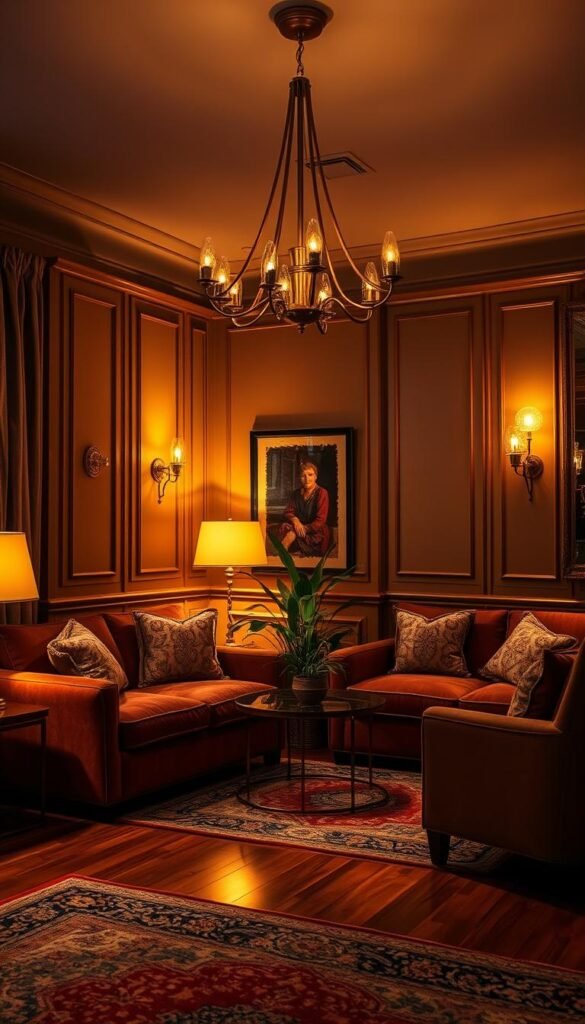
Layering Lighting for Warmth and Depth
Three-tiered lighting creates adaptable moods. Begin with dimmable ceiling fixtures set at 50% brightness – this base layer mimics natural dusk. Add task lighting like adjustable wall sconces near reading nooks. Finish with accent LEDs beneath shelves to highlight decor.
Consider these living room tips:
- Table lamps with linen shades soften harsh overheads
- Pendant lights above side tables create intimate pools of light
- Battery-operated candles add flicker without fire risk
Elevating Everyday Items to Luxe Statements
Ordinary objects become art through intentional styling. A ceramic vase holding dried branches transforms when painted matte black and lit from below. Stack hardcover books vertically, their spines color-coordinated with your room feel palette.
Try these decor upgrades:
- Display coffee table trays with sculptural bookends
- Drape velvet fabric over basic ottomans
- Use brass cloches to showcase collected stones
These refinements add personality without clutter. Your space whispers sophistication through curated details that serve both form and function.
Innovative Use of Corners and Unique Configurations
Have you considered how those awkward angles could become your home’s most charming features? Neglected corners hold untapped potential when approached with creative vision. Top interior specialists reveal that unconventional layouts often yield the most personalized solutions.
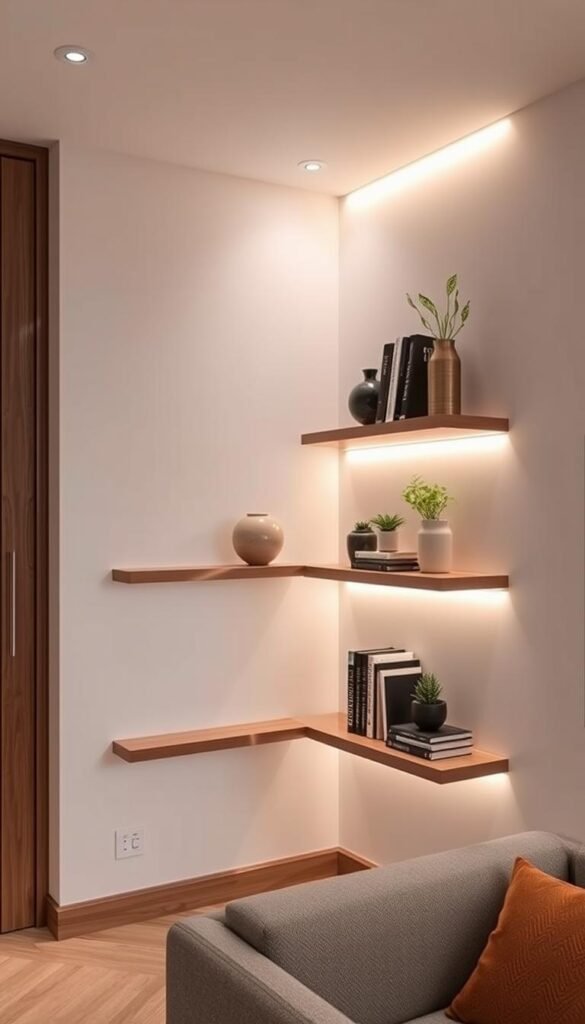
Breathing Life into Forgotten Spaces
That triangular nook by the staircase? It’s a reading retreat waiting to happen. Custom shelving hugging walls transforms dead zones into display galleries for art or plants. A designer client recently converted a 22-inch sliver between cabinets into a vertical herb garden – functional and fragrant.
Consider these ways to reimagine challenging areas:
- Floating desks that pivot into closed cabinets
- Corner banquettes with under-seat storage
- Angled bookshelves following room contours
Make sure your solutions honor both form and flow. Built-in seating along angled walls creates intimate dining spots without blocking pathways. For sloped ceilings, low-profile storage units maintain headroom while housing essentials.
The magic lies in seeing limitations as invitations. That oddly shaped alcove becomes a wine niche when lined with reclaimed wood. Your home gains character through these intentional adaptations – proof that smart design thrives where standard layouts end.
Conclusion
Creating elegance in compact homes requires balancing practicality with imagination. Every choice—from paint colors that stretch walls to multi-level lighting that sculpts depth—builds toward cohesive sophistication. Remember: harmony emerges when storage solutions whisper and furniture sings.
Those designer insights from Dallas experts prove transformative. A living room thrives with vertical shelves that store and display. Kitchens gain charm through fold-out counters that vanish after brunch. Each room becomes a testament to intentionality.
Maintain momentum by editing often. Rotate decor seasonally, letting favorite pieces shine without clutter. Test layouts using painter’s tape before drilling—flexibility prevents design fatigue. When walls feel restrictive, look upward: ceilings offer untapped potential for hanging plants or pendant lights.
True refinement lies not in square footage, but in how elements converse. A velvet ottoman complements matte floors. Frosted glass partitions divide areas without blocking light. Your home tells its story through these thoughtful dialogues.
Start small, dream big. That corner nook? It’s a future reading sanctuary. The narrow hallway? An art gallery in waiting. With each strategic choice, you’re not just decorating space—you’re curating an experience that feels both expansive and intimately yours.

